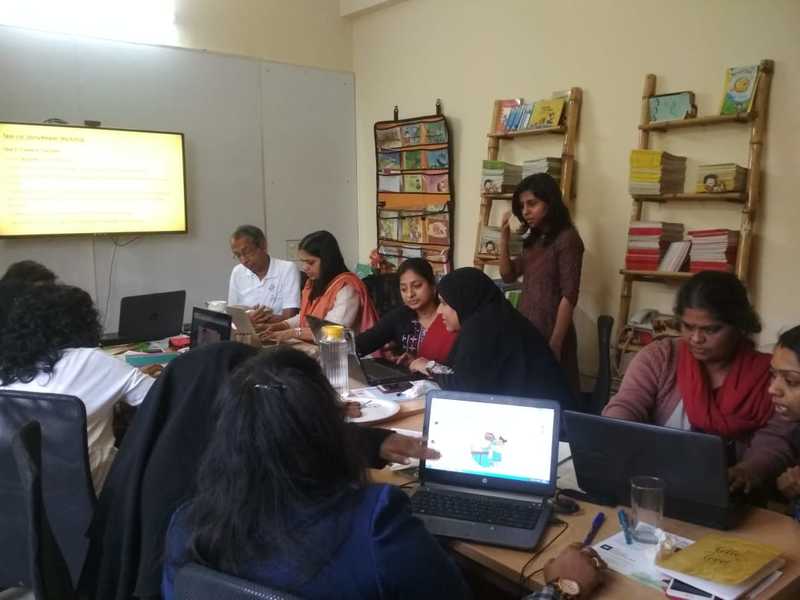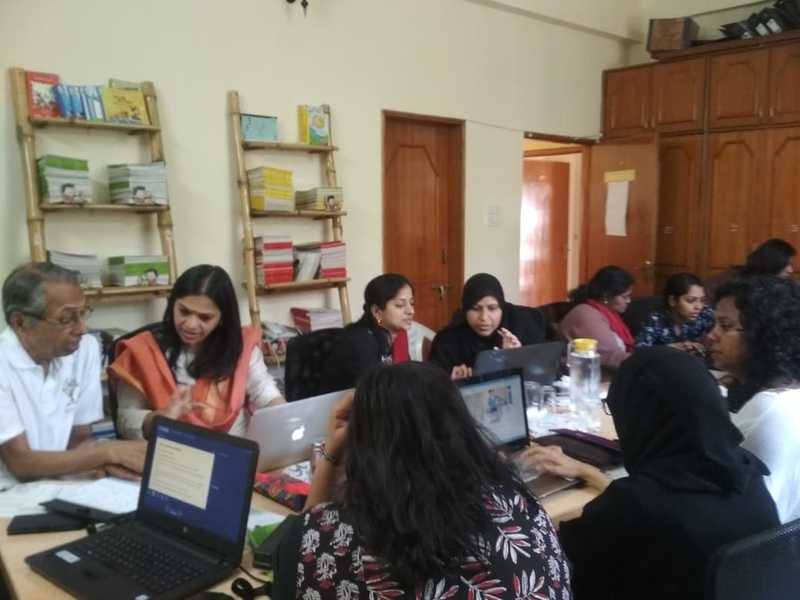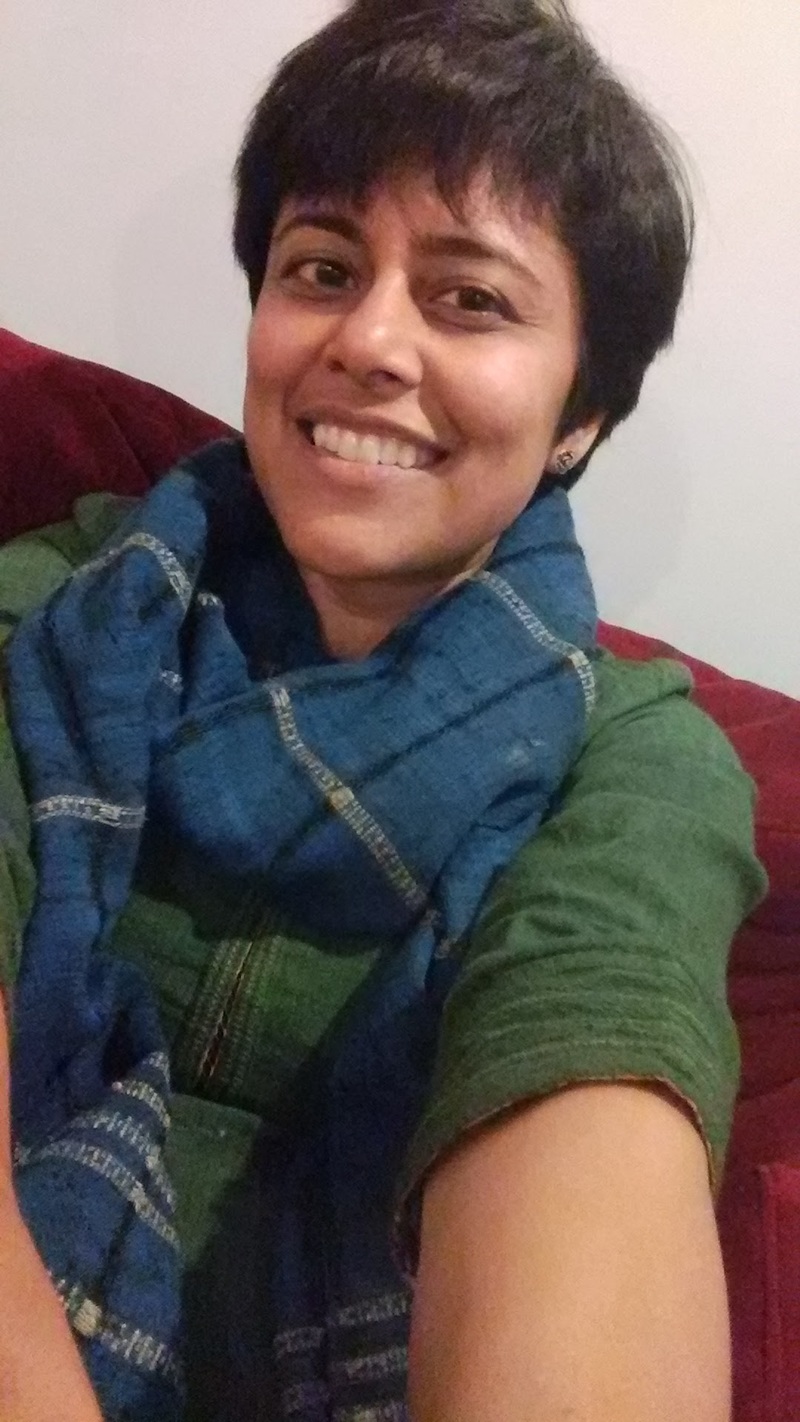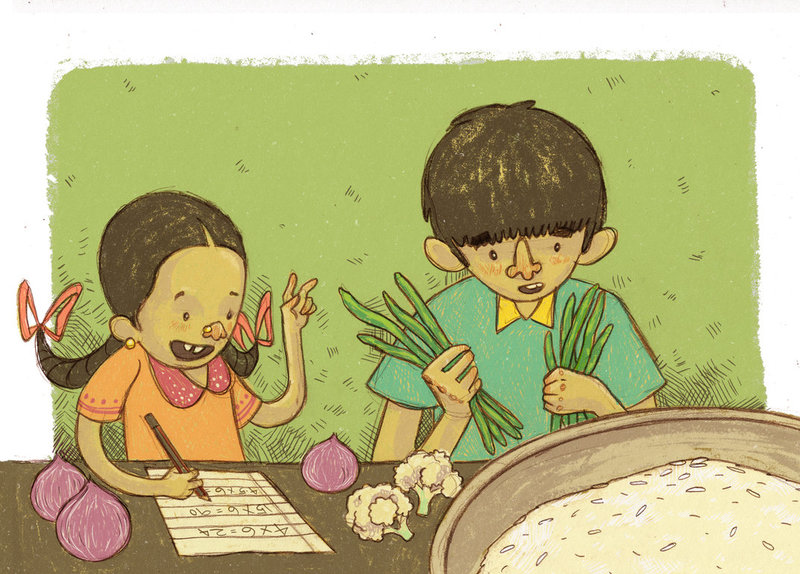StoryWeaver's first workshop of 2019
Posted by Priyanka Sivaramakrishnan on February 13, 2019Vineetha from the Partnerships team talks about the first StoryWeaver workshop of 2019
The best part about being in a room full of educators is the stories they always have to share. And, what makes this even better? A room full of educators in a workshop on, yes, stories.
This January, we hosted the first StoryWeaver workshop of 2019 at the Pratham Books office in Bangalore - a day full of classroom stories, sharing, and smiles. Workshops are a great opportunity for us to interact with educators from across organisations who can help take the magic of stories to more children and classrooms.
This workshop had participants from a range of organisations - from curriculum designers to CSR professionals to project coordinators to teachers, both young and experienced. What they all shared was their love for books, their belief in the power of stories as resources in classrooms, and an excitement to take the learnings from the workshop back to the children they work with. We had participants from Parikrma foundation (who run an end-to-end program where children receive education right from kindergarten to college), Orchids school, Naasih public school, BrickWork Foundation, and Youth4seva (who support schools, destitute shelters, government hospitals and other organizations in the social sector through their volunteers). As participants joined us at the brightly coloured Pratham Books conference room, the venue of our workshop, I could observe how keenly they were looking to absorb everything they could to take back to the classroom.
As we started the session with the story No Smiles Today, I couldn’t stop smiling as I saw the participants enthusiastically participate in the discussions. As people who often have to don multiple hats in the classroom - teacher, mentor, guide, parent, confidante, I couldn’t help but notice how deeply they were immersed in their new roles for the day - that of students. It was wonderful to see their eyes light up when they saw a story they liked, their animated discussions when they had something to share, and the smiles on their faces as they spoke about their students and classrooms.

In the next session, we began exploring how the content on StoryWeaver could best be used in the classrooms to improve learning, increase engagement, and create joyful learning spaces. Through my journey as a teacher, I had often found myself underwhelmed and overwhelmed at the same time - underwhelmed by the lack of contextual reading material for my students, and overwhelmed by the work there was to be done to bridge that gap.
Even on StoryWeaver, I could see how a new user could be overwhelmed at the prospect of browsing through over 11,000+ stories. Through our workshops, we’re trying to understand what exactly teachers are looking for and to make that process faster and easier. Many of our features such as Lists - a section on StoryWeaver which has curated sets of stories, categories, and themes such as Lifeskills, Humour, and more, have come about as a result of our interaction with the educator community. Another challenge that most teachers face is handling the different reading proficiency levels in the same classroom. One of the participants from Parikrama shared how her guiding principle through 11 years of teaching has always been to not leave a single child behind in her classroom and to ensure that she does whatever it takes to cater to every child’s unique needs. Participants agreed that the Re-level feature on StoryWeaver is a great way to differentiate instruction in the classroom using different versions of the same story, so children at the same cognitive level but different reading ability levels are still able to enjoy the same story.
As we explored the different categories and themes on StoryWeaver, it was heartwarming to see how educators were looking for resources to raise more sensitive children and create inclusive learning spaces. One of our participants shared how fun stories like the GIF story, Gappu Can’t Dance, can be used to discuss difficult topics like bullying, and also to touch upon diversity and acceptance in the classroom and beyond. Another participant shared how stories like Angry Akku could help integrate aspects of Social Emotional Learning into the curriculum.
Another aspect that really shone through was how participants come up with cross-disciplinary use cases for the same stories. So, for example, the story, When Will Amma Be Back, could be used to integrate concepts as diverse as reading time, numbers, and even grammar concepts like verbs. Participants working with young children remarked how the Readalong feature could be a great way to build reading fluency while also teaching more advanced concepts like punctuation, intonation, and reading with expression.

Once the participants began working on their own stories, the space was buzzing with ideas, suggestions, and questions. As they created their own stories and translated existing ones, they debated the choice of words and their reasons for why a certain word should or should not be used. For us at StoryWeaver, these sessions are enormously helpful as the educator lens has been critical to developing and guiding some of the most popular StoryWeaver features. By the end of this session, as participants shared their stories and saw their published stories show up on ‘New Arrivals’, we knew this had been an afternoon well spent for all of us.
All through the day’s session, I couldn’t help but notice how big a role stories play in our lives. As the academic year comes to a close, we would like to thank all our wonderful participants for making these workshops an amazing learning experience for us and more importantly, for helping us take the magic of stories to children across the country.
If you are interested in hosting a similar workshop for your organisation, drop us an email on [email protected]
Be the first to comment.
Wider Net: Providing access to educational resources
Posted by Remya Padmadas on July 05, 2016The WiderNet Project is a non-profit organization affiliated with the University of North Carolina, Chapel Hill that promotes low-cost information and communication for underserved populations.
The eGranary Digital Library, also known as "The Internet in a Box", is an off-line information repository that delivers over 32 million educational resources to people living in underserved areas of the world. The eGranary Digital Library delivers digital information directly to Web servers inside subscriber institutions, bypassing bandwidth problems. Many subscriber institutions have no internet access or an internet connection experience that is slow, unreliable and very expensive. With the eGranary Digital Library, thousands of people can access the information over their local area networks quickly and at no cost.
The eGranary is already installed at over 1,200 universities, schools, health care centers, and libraries worldwide. They have a huge presence in Africa and India, and in India, they work with a number of organizations, including Samarthanam Trust for the Disabled, Karnataka, Tibetan Children's Village, Himachal Pradesh, AKSHAYA Rehabilitation Trust, Tamil Nadu, Association for Rural Development and Action Research, Vizianagaram and Andhra Pradesh, Blind Peoples Association, Gujarat, India.
Laura Ashcraft, a Digital Librarian at The Wider Net Project, generously took the time to answer some questions for us about the project.
Q: How do you find potential content providers?
Usually what I do is add and organize content for a set of domains (think special libraries) that I manage. I am either actively looking through the Internet or databases, or I stumble across a viable candidate whilst looking for something else. The key is keeping the projects organized. Much of what we seek is inspired by requests we get from subscribers and users.
Q: Do you have any criteria by which you screen content that is shared on the eDigitalGranary? Who does this screening?
Of course, it goes without saying: no pornography, nothing demeaning or incendiary. On top of this:
· Educational (content must add to a user’s knowledge and/or skill level)
· Domain specific (creating a special library, what we call portals)
· Reliable (the source is vetted as either being produced by a professional or the content is well researched)
· Trustworthy (the content is produced by organizations or individuals who stand by their work.)
For example, StoryWeaver presents not only a wide variety of children’s stories, but the stories themselves do not intentionally portray any culture in a negative light. And of course, I always ask myself does this content serve our community in the most beneficial way?
The content is screened by the librarians here at the WiderNet. If we have a question (content too provocative, is there a broader bias which makes us uneasy, might there be another site that has similar content, etc.?), we consult with our librarian colleagues at UNC or professionals in the respective fields.
Q: Do you customise content on the digital eGranary based on the organisation (school, college etc.) or based on geographical location?
We customize content as per organization request. Not by limiting or subtraction, but by highlighting information that meets a particular group’s needs. This usually means we create a portal and organize existing content within the eGranary around those specific categories. We also actively acquire new content from site providers. Sometimes our volunteer librarians express an interest in a subject we have not explored and they build a portal based on this interest.
Q: Do you have a system by which you can track the number of reads/downloads etc of content on a digital granary? Do you ever look at or analyse this data?
Occasionally we get Apache server logs from our subscribers. We then learn about “hits” (how many times a page is visited or a document downloaded.) Given that most of our subscribers don’t have an Internet connection, this can get awkward.
Q: How often is content on a digital eGranary box updated to keep it relevant?
About twice a year we update the collection that goes out the door. Some organizations purchase an updated drive every couple years, others run the drive until they die. (The medical school in Liberia had theirs up for nine years!) However, subscribers can update the collection by adding their own content on-the-fly.
WiderNet’s latest project is the Pocket Library project. These are chip-sized libraries for specific populations. An Ebola Pocket Library the organisation created in 2015 made them realized the potential application of the "library on a chip" concept.
Q: The Pocket Library sounds like an amazing idea. Could you share details about its progress?
The last pocket library we built was called Girls Can Code – Ethiopia. With the help of our colleagues in Durham NC and Ethiopia we developed a curriculum to teach 40 high school teenage girls about ICT, from building a physical computer, understanding Windows and software application, creating their websites, and finally programming. The librarians’ job was to help develop the curriculum, acquire the resources both in the eGranary and without, and build a website for the project. We had technical staff work on the scraping and troubleshooting and all the other myriad things that must be done to get the content to work as it does on the live internet. This is no small job, but it is incredibly satisfying to know that these USBs are going to be used and kept as a resource for continued education and growth. You can read about that here and here.
WiderNet is in the process of ‘scraping’ the StoryWeaver site to include on their eGranaries. ‘Scraping’ is the process of essentially copying a site. The trick is to get all the functions to work offline as they do online.
Watch this space for updates about StoryWeaver on eGranaries. You can follow Wider Net on Twitter @WiderNetProject
Be the first to comment.A Mathematical Journey
Posted by Remya Padmadas on March 01, 2016
Roopa Pai is a computer engineer who always knew she was going to write for children. She is the author of Taranauts, India's first fantasy-adventure series for children in English,and several others, including some for Pratham Books. Her latest bestseller is 'The Gita For Children'.
This is why I love my job. Every so often, a project comes along that holds out the tempting prospect of a never-before challenge. I take such projects on with (an admittedly nervous) alacrity, because a challenge helps to keeps things fresh - it forces one to shift gears, to look at things through someone else's eyes, to tap into hitherto unexplored veins of creativity. And when it has been met to the best of one's ability, a challenge leaves one with a sense of accomplishment, of life having been enriched in some small way.
It was precisely such a challenge that Pratham Books' Storyweaver initiative dropped into my lap a few months ago. We want to create wonderful new stories, they said, and we want to create them quick. We want to hear new voices, on a myriad subjects. We want to help children discover disparate worlds - math, the environment, artificial intelligence, good values - through stories that are fun, engaging, and lushly illustrated. And we want to share them all, translated into a dozen different languages, with the world.
And once it is all online, they said, their eyes shining, anyone, anywhere in the world will be able to read them, for free! What's more, anyone, anywhere, can download them, print them, distribute them, translate them into any language in the world, use pictures from different books to weave new stories, or weave together different story threads to spin out brand new tales. Wasn't it all terribly exciting? And would I please be part of it?
It most certainly was, I said. And of course I would!
And that's how I landed my first job as editor. 'Guest editor', more correctly, with the responsibility of finding new children's writers, and generating, through them, four stories involving maths. The stories could be fiction or non-fiction, but they would have to deal with mathematical themes. As a sop to a first-time editor, they graciously allowed that I could write one of the stories myself.
I tossed ideas around in my head - what themes existed in primary-school level maths? Numbers, distances, patterns, measurements, arithmetic... What stories could be woven around them? The Storyweaver team and I went back and forth for weeks, until we came up with a list of ideas that we all agreed held promise. Then I went out to look for my crack team of debutante writers.
I didn't have to look far. Over the past couple of decades, I have had the pleasure of interacting and working with a number of talented, accomplished people who also work with children, but not necessarily as writers. When I had sliced and diced that contacts list to find people with backgrounds in science and / or math, AND people who lived in Bangalore (this for no other reason than that editorial meetings could then involve lots of laughing and chai-drinking), three names emerged. Fortunately for me, they all agreed instantly to be collaborators on an adventure that was new for all of us.
And who were these three people?
There was Gayathri Tirthapura, who trained as an engineer at REC (now NIT) Surathkal, before going off to the US for a double masters (Masters in Science from Stanford, Masters in Education from Harvard) and 10 years in the telecom industry. Since she returned a few years ago, Gayathri has run Kutoohala, a children's activity centre, library and bookstore where she puts all her theories on what makes for a fun, enriching education into practice.
There was Sukanya Sinha, a PhD in Physics from the University of Maryland, who has held research positions in several scientific institutes not just in India but elsewhere and is now a Visiting Professor at the Indian Statistical Institute. But Sukanya is also as much at home with demystifying complex scientific concepts to children - she is part of the founding team of Curiouscity, an organisation that promotes creativity in science among young people.
And there was Shonali Chandy Chinniah, a marine biologist from Cornell who has taught undergrad courses at both American and Indian universities, apart from conducting educational tours at the New Jersey Aquarium and working with NGOs in India to promote science education among the less privileged. Shonali is also part of the founding team of Curiouscity.
Over the course of the next few weeks, at several delightful and wonderfully stimulating editorial meetings (given the formidable - and creative - brainpower I was dealing with, it could not have been any other way), we picked different ideas, toyed with them, wondered if they would work better as fiction or non-fiction, and drank plenty of chai. Then everyone went off to write their stories.

The results of that most enriching experience is - or will soon be - up there on Storyweaver for all of you to enjoy. Already up are Sukanya's awe-inspiring non-fiction story on distances - 'How Far is Far?', and Gayathri's heartwarming fiction story on math in cooking - 'Dum Dum-A-Dum Biryani'. Coming up soon are Shonali's enjoyable non-fiction story - The Fabulous Fibonaccis - on the endlessly fascinating number sequence called the Fibonacci (or Hemachandra) sequence, and my own fiction story based on history and arithmetic - How Old Is Muttajji?
How would I rate my editorial challenge on a scale of 1 to 10? I would go off the scale - it's all allowed in maths - and say 0. Because, like that old song goes, no matter how big the challenge, you can always get by with a little help from your friends.
Be the first to comment.